Commissioning Guide
Let's get your V-Core 4.0 moving!
This guide is meant to assist you in getting started with your freshly assembled standard V-Core 4.0 Kit. The entire mechanical and electronics assemblies must have been completed before. There are many ways of commissioning a 3D printer, but this guide is optimised for the V-Core 4.0. It aims to be the easiest, and most simple way to get your machine up and running.
About the Commissioning:


